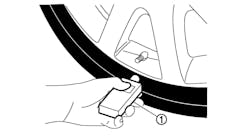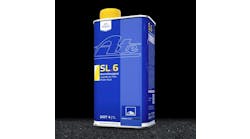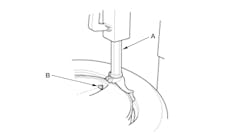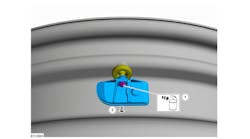SUBJECT VEHICLES: 2006-2012 GM/Chevy Colorado and Canyon.
RELEARN PROCEDURE? Yes.
SPECIAL TOOLS NEEDED? No.
The tire pressure monitoring system (TPMS) notifies the driver when a significant loss of tire pressure occurs in any of the four tires. The system uses the powertrain control module (PCM), body control module (BCM), instrument panel cluster (IPC), driver information center ( DIC), a radio frequency (RF) transmitting pressure sensor in each wheel/tire assembly, and the serial data circuit to perform the system functions.
When the vehicle is stationary the sensor’s internal roll switches are open, which puts the sensors into stationary mode. In this mode the sensors transmit once every 60 minutes to minimize sensor battery consumption. As vehicle speed increases, centrifugal force closes the sensor’s internal roll switches causing the sensors to go into drive mode. In this mode the sensors transmit once every 60 seconds. The BCM receives and translates the data contained in each sensor’s RF transmission into sensor presence, sensor mode, and tire pressure.
NOTE: The sensors pressure accuracy from -10 to +70 degrees Celsius is ±7 kPa. The BCM has the ability to detect malfunctions within the TPMS.
TPMS warning indicators
When the TPMS detects a significant loss of tire pressure, the CHECK TIRE PRESSURE message is displayed on the DIC and the low tire pressure indicator is displayed on the IPC. Both the message and indicator can be cleared by adjusting the tires to their recommended pressures. The TPMS warns the driver when a significant loss of tire pressure occurs in any of the four tires, and allows the driver to display the individual tire pressures and their locations on the DIC while the vehicle is being driven. Any malfunction detected will cause the DIC to display the SERVICE TIRE MONITOR message.
Reset procedures
NOTE: When the wheels have been rotated, or a tire pressure sensor has been replaced, retrain the tire pressure sensor.
NOTE: Once the TPMS learn mode has been enabled, each of the sensors’ unique identification (ID) codes can be learned into the BCM memory. When a sensor ID has been learned, the BCM sounds a horn chirp. This verifies the sensor has transmitted the ID and the BCM has received and learned it. The BCM must learn the sensor IDs in the proper order to determine correct sensor location. The first learned ID is assigned to the left front, the second to right front, the third to right rear and the fourth to the left rear.
NOTE: Sensor functions using a scan tool — Each sensor has an internal low frequency (LF) coil. When the tool is used in activate mode it produces an LF transmission that activates the sensor. The sensor responds to an LF activation by transmitting in learn mode.
When the BCM receives a learn mode transmission while in the TPMS learn mode, it will assign that sensor ID to the location on the vehicle relative to the order in which it was learned.
NOTE: Sensor functions using pressure increase/decrease method — Each sensor takes a pressure measurement sample once every 30 seconds while in stationary mode. If the tire pressure increases or decreases by more than 8.3 kPa (1.2 psi) from the last pressure measurement, another measurement will occur immediately to verify the change in pressure. If a pressure change has indeed occurred, the sensor transmits in re-measure mode. When the BCM receives a re-measure mode transmission while in TPMS learn mode, it will assign that sensor ID to the location on the vehicle relative to the order in which it was learned.
NOTE: Learn mode cancellation — The learn mode will cancel if the ignition is cycled to OFF or if more than two minutes has elapsed for any sensor that has not been learned. If the learn mode is cancelled before the first sensor is learned, the original sensor IDs will be maintained. If the learn mode is canceled for any reason after the first sensor is learned, all IDs are erased from the BCM memory and if equipped, the DIC will display dashes for tire pressures.
WARNING: Stray signals from other TPMS-equipped vehicles just driving by can be inadvertently learned. If any random horn chirps are heard from the vehicle while performing the learn procedure, most likely a stray sensor has been learned and the procedure will need to be cancelled and repeated. Under these circumstances, performing the TPMS learn procedure away from other vehicles would be highly recommended.
NOTE: In the event a particular sensor activation does not cause the horn to chirp, it may be necessary to rotate the wheel valve stem to a different position due to the sensor signal is being blocked by another component. Before proceeding with the steps below, verify the following:
- No other sensor learn procedure is being performed simultaneously within close proximity.
- Tire pressures are not being adjusted on another TPMS-equipped vehicle within close proximity.
- Park brake and head lamp switch input parameters are functioning correctly.
1) Turn ON the ignition, with the engine OFF.
2) Apply the parking brake.
3) Turn the headlight switch from OFF to parking lamps four times within four seconds. A horn chirp will sound and the low tire pressure indicator will begin to flash indicating the learn mode has been enabled.
4) Starting with the left front tire, learn the tire pressure using one of the following methods:
- Method 1: Hold the antenna of the tool against the tire sidewall close to the wheel rim at the valve stem location then press and release the activate button and wait for a horn chirp.
- Method 2: Increase/decrease the tire pressure for eight to 10 seconds then wait for a horn chirp. The horn chirp may occur before or up to 30 seconds after the eight to 10 second pressure increase/decrease time period has been reached.
5) After the horn chirp has sounded, repeat the procedure for the remaining three sensors in the following order: right front, right rear, left rear.
6) After the LR sensor has been learned, a horn chirp will sound indicating all sensors have been learned.
7) Turn OFF the ignition to exit the learn mode.
8) After the learn mode has been exited, adjust all tires to the recommended pressures.
Demounting/mounting procedures
CAUTION: The tire should be demounted from the wheel using the tire changer manufacturer’s instructions. Use the following information to avoid damage during the demounting/mounting procedures.
NOTE: If the vehicle’s tires are replaced with those not having a TPC spec number, the TPMS may give an inaccurate low pressure warning. Non-TPC spec tires may give a low pressure warning that is higher or lower than the proper warning level achieved by TPC spec numbered tires.
NOTE: When the wheels have been rotated, or a tire pressure sensor has been replaced, retrain tire pressure sensor. See reset procedures.
Tire pressure sensor
CAUTION: DO NOT inject any tire liquid or aerosol tire sealant into the tires, as this may cause a malfunction of the tire pressure sensors.
If any tire sealant is noted upon tire demounting, replace the sensor.
Also remove all residual liquid sealant from the inside of the tire and wheel surfaces.Removal
1) Raise the vehicle on a suitable support. Remove the tire/wheel assembly from the vehicle.
2) Demount the tire from the wheel following the tire changer manufacturer’s instructions while paying special attention to the following to avoid damaging tire pressure sensor:
- Place the sensor’s cap and valve on a dry, clean surface after removal. The cap is aluminum and the valve is nickel-plated to prevent corrosion. DO NOT substitute a cap or valve made of any other material.
- Position the bead breaking fixture 90 degrees from valve stem when separating the tire bead from the wheel.
- Position the mounting/demounting head so the tire iron can be inserted slightly clockwise of the sensor body when prying tire bead up and over the mounting/demounting head.
- Using a tire machine, rotate the tire/wheel assembly clockwise when transferring the tire bead to the outside of the wheel rim.
- Repeat these steps for the inner bead.
3) Remove the tire pressure sensor nut (see Figure 1).
4) Remove the sensor from the wheel hole.
5) Remove the sensor grommet from the valve stem.
Installation
1) Clean any dirt or debris from the grommet sealing areas. Install the grommet on the sensor valve stem.
2) Insert the sensor in the wheel hole with the air passage facing away from the wheel.
3) Install the sensor nut, and position the sensor body parallel to the inside wheel surface while tightening nut to 62 in.-lbs. (7 N.m).
4) Before installing the tire on the wheel, note the following items to avoid tire pressure sensor damage upon tire mounting:
- Position the mounting/demounting head 180 degrees from the valve stem. Position the bead transition area 45 degrees counterclockwise of the valve stem.
- Using a tire machine, rotate the tire/wheel assembly clockwise when transferring the tire bead to the inside of the wheel rim.
- Repeat these steps for the outer bead.
5) Install the tire on the wheel. Install the tire/wheel assembly on the vehicle. Retrain the tire pressure sensor (see reset procedures).
NOTE: A service replacement tire pressure sensor is shipped in the OFF mode. In this mode, the sensor’s unique identification code cannot be learned into the memory. The sensor must be taken out of OFF mode by spinning the tire/wheel assembly above 20 mph (32 km/h) for at least 10 seconds in order to close the sensor’s internal roll switch.
Torque specifications
Component Ft.-lbs. (N.m)
Wheel nut 100 (140)
In.-lbs. (N.m)
Tire pressure sensor nut 62 (7)
Information for this column comes from Mitchell 1’s “Tire Pressure Monitoring Systems Guide” for domestic and import vehicles. Headquartered in Poway, Calif., Mitchell 1 has provided quality repair information solutions to the automotive industry for more than 80 years. For more information, visit www.mitchell1.com.
To read more TPMS columns, see:
2011-2015 Chrysler Ram Pickups
Hyundai Sante Fe and Sante Fe Sport 2010-2016




